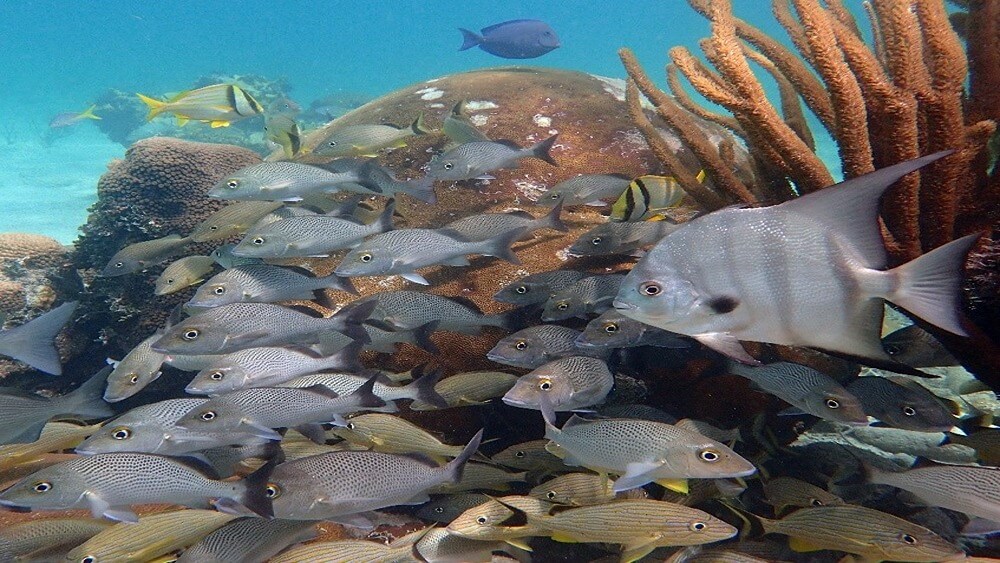Population Dynamics of Fish
Conservation Issue
Finfish are a vital part of the ecosystem and economy of the Florida Keys. Decades of overfishing and habitat loss have taken their toll, and fish populations will continue to be affected by increasing fishing pressure as human populations increase. Fishery management strategies have been adopted in response to changes in the structure of fish stocks for commercially and recreationally targeted species, but there remains a need for additional measures to protect targeted species and other ecologically important species, as well as efforts to enhance connectivity of fish populations and restore fish habitat throughout Florida Keys National Marine Sanctuary (FKNMS).

Description
The Florida Keys have supported a recreational and commercial fishing community for over a century, but increasing concerns have been expressed that these fisheries may not be environmentally sustainable over the long term. While numbers of commercial fin fishery trips remain at levels below their 1995 peak, technological advances have increased fishing efficiency, and fish populations are under increasing pressure as a result of large increases in numbers of recreational anglers. Threats from fishing have been associated with direct take, bycatch of non-target species, habitat damage from the use and loss of fishing gear, as well as trophic cascades through reef fish assemblages and ecological effects on the ecosystem, such as reduced herbivory and benthic phase shifts from coral to algal dominance. The effects of fishing on coral reefs are compounded by the accelerating rates of habitat degradation as a result of changing ocean conditions and other stressors, and these changes have been associated with fewer small-bodied juveniles and prey that replenish stocks and provide dietary resources for predatory target species.
Key fishery management measures such as size limits, bag limits, gear restrictions, and seasonal and spatial closures have helped more effectively manage these resources. However, there are gaps in information on habitat utilization and migratory patterns of different life stages, locations, and behavior of fish, as well as the appropriate spatial and temporal scales needed to protect both ecologically and economically fish species within FKNMS. In addition, more information on linkages between reef fish assemblages and habitat quality and condition is needed to identify, adapt, and implement restoration strategies and inform management on zoning and regulations.
Data and Analysis Needs
- Effectiveness of habitat restoration on fish biodiversity through comparisons of fish community structure at restoration sites and similar, unrestored habitats
- Effectiveness of the existing network of marine reserves in FKNMS for protecting ecologically and economically relevant fishes, with emphasis on the size, location, degree of connectivity, and inclusion of different habitat types utilized by different life stages of fishes, and identification of potential modifications to existing zones that could further protect and rebuild vulnerable fish stocks
- Comparison of fish community structure within fully protected areas with similar habitats that are not protected, and additional zoning, boundary, and regulatory changes that could further protect ecologically and economically relevant fish species
- Relationships between coral community structure, health, and extent of degradation of coral reef habitats and fish community structure and stability
- Patterns and frequency of adult fish movement within FKNMS, how adult fish movement within the sanctuary changes during ontogeny, and the effect of changing ocean conditions on habitat utilization patterns and fish movement
- Role of permitted artificial habitats (e.g., the USNS Hoyt S. Vandenberg) on local fish communities and potential cascading impacts on adjacent natural habitats
- Diversity, status, and trends of mesophotic and sub-mesophotic fish species, their ecology, habitat utilization patterns, and relationship between the condition of these deeper habitats and their abundance and biodiversity
- Species-specific life history information, such as growth rates and size at maturity for poorly studied reef fish species
- Relationships between larval connectivity, recruitment patterns, and trophic relationships in exploited and unexploited reef fish in healthy, self-sustaining coral reef communities and implications of reef degradation for these metrics
- Linkages among multiple stressors (physical, chemical, ecological, and human impacts) and their effects on reef fish populations
- Socioeconomic effects of management decisions on stakeholders
Potential Products
- Fisheries management strategies and stock assessments for poorly studied reef fish species based on life history information (e.g., growth rates, size at maturity)
- Spatial/temporal reef fish utilization map of the shallow nearshore hardbottom and nursery habitats for both exploited and unexploited reef fish species
- Habitat utilization models at appropriate spatial and temporal scales that enable managers to utilize geographic and temporal zoning as a tool for protection, restoration, and conservation of resources
- An ecosystem model for reef fish communities to predict cascading effects of zoning on reef fishes
- Data support tool that collates finfish information from a variety of monitoring programs, is routinely updated, and allows resource managers and the public to quickly understand any change in patterns at different spatial scales
For more information about this assessment, contact Andy.Bruckner@noaa.gov.

